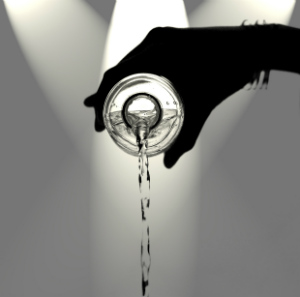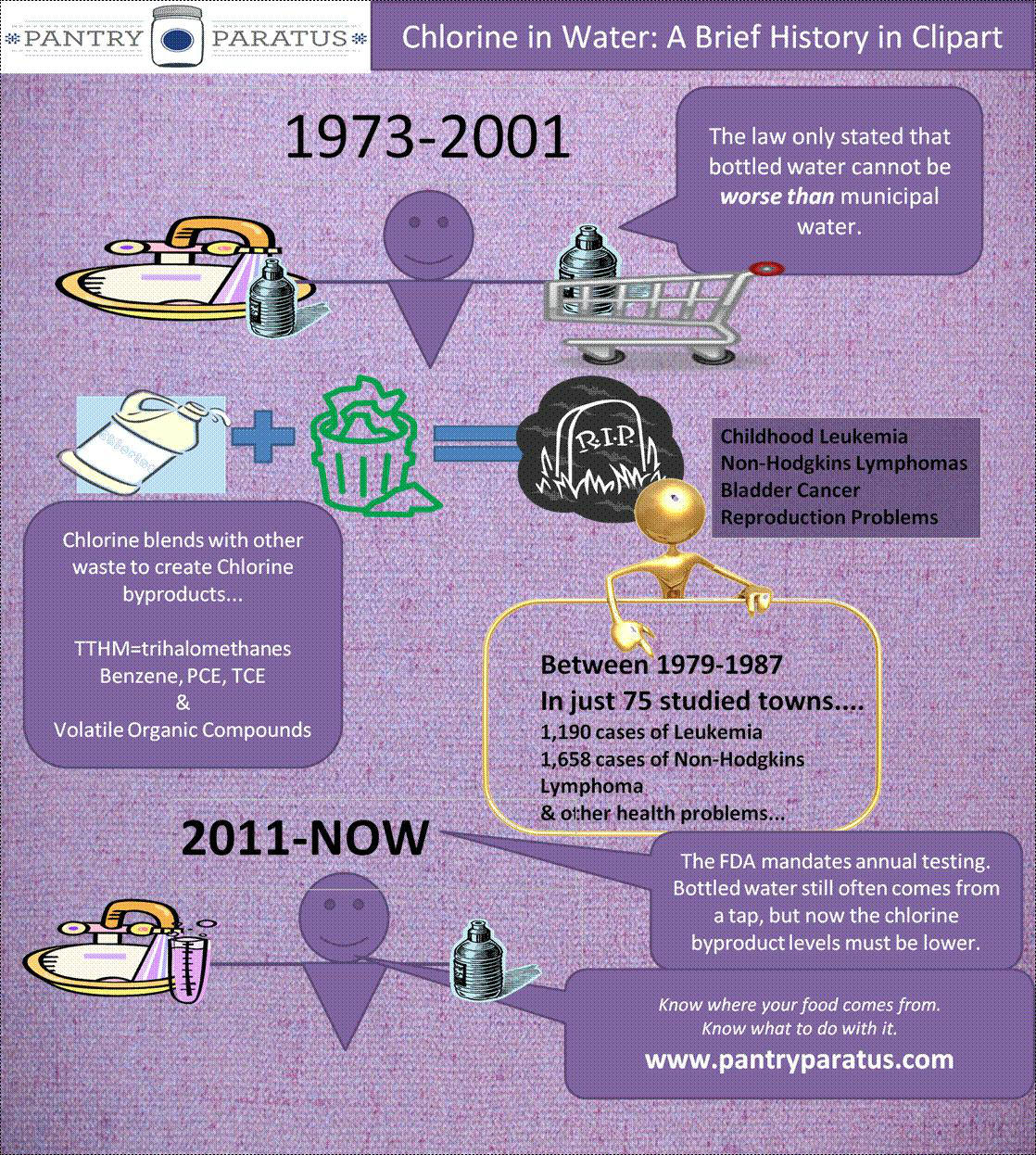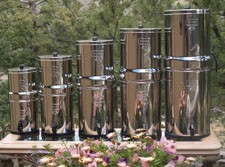When It Tastes Like the Pool
Chlorine in Water
Chlorine in tap water can kill your plants. But it is good for you, right?
Chlorinated water. There are many of us who would rather not find out the hard way. And so the choices, if you live in a city that puts chlorine in the drinking water, is to either buy bottled water or filter the chlorine out.
I’ve put together a pictograph to explain it all…
We’ve all swallowed chlorine in pool water. Who cares about chlorine?
It turns out that the very thing added to keep us from getting sick—all of the chlorine—adds with debris and waste to create carcinogens (cancer-causing substances). Specifically, the two mix to create trihalomethanes (TTHM) Benzene, PCE and TCE. Volatilve Organic Compounds (VOC) is another fancy way of saying that the bleach mixes with debris or waste to create these toxic byproducts. The links were discovered back in the 80’s that show high levels of childhood leukemias, Bladder cancer, and Non-Hodgkins Lymphomas in places with high TTHM levels ((Cohn, Bove, Klotz, Berkowitz & Fagliano, 1993). Twenty-five years later with irrefutable science, people are still poisoning our water and we are still drinking it.
What is the law for bottled water? Bottled water cannot be WORSE than public water….
Up until 2001, the standard for bottled water was as follows:
“…shall require that bottled water be subject to requirements no less protective
of the public health than those applicable to water provided by public water systems
using the treatment technique required by the national primary drinking water regulation.” (pg 108, Title 21—Food and Drugs)
Plain English: Bottled water can be every bit as rotten as municipal water, but cannot be more rotten. Actually, that’s still on the books. But in 2001, there was a new requirement for all bottled water to test once a year to ensure that bottled water met the new criteria for: residual disinfectants chloramine, chlorine, and chlorine dioxide and for three types of disinfection byproducts (DBPs), bromate, chlorite, and haloacetic acids (HAA5), and for the DBP total trihalomethanes (TTHM). The very things they now require be kept low are the effects of chlorine in water.
Municipal Water gets by with more than bottled water because there are the pipes to contend with, often a heavy hitter in the lead department. Bottled water, with chlorine byproduct levels set low in 2011, must be tested every year to verify its’ safety. Bottled water is still largely municipal water, but it must either clean up its’ act before bottling, or choose a pretty clean city. Still, much more testing needs to be done to see what long-term exposure to chlorine in drinking water at low levels may do. There are also certain populations that are more vulnerable. People with occupational hazards, smokers, elderly, disabled, and women are most at risk.
And we have not even discussed the bottle as packaging, BPA, plastic heated to cooking temperature (left in your car on a hot day), and shelf life.
The best option
I cannot hide my bias on this one. I have done my own research and I am appalled that a lifetime of studies and grant money and dead people have led us…back to where we started. Chlorinated water. Is there no better option? Perhaps not on a mass scale. But why are will still drinking it? The option our family chose was a gravity-fed purification system. Consider it—it’s far cheaper than having water brought in, your water is not touching plastics, and it is extremely low maintenance!
Below is a list of what the Berkey Purification System eliminates from your water. I am only focusing on the chlorine and chlorine byproducts known to cause cancer and lymphoma, so I’ve highlighted those in yellow:
VIRUSES >99.999%
Exceeds purification standards:
MS2 – Fr Coliphage
PATHOGENIC BACTERIA, CYSTS AND PARASITES >99.9999%
Exceeds purification standards:
E. Coli – Klebsiella Terrigena – Pseudomonas Aeruginosa – Giardia – Cryptosporidium – Raoultella Terrigena
TRIHALOMETHANES
Removed to below detectable limits:
Bromodichloromethane – Bromoform – Chloroform – Dibromochloromethane
RADIOLOGICALS
Removed to below detectable limits:
Radon 222
INORGANIC MINERALS
Removed to below detectable limits:
|
CONTAMINANT |
|
Chlorine Residual |
|
Volatile Organic Compounds (VOCs) |
|
|
Alachlor |
Ethylene Dibromide (EDB) |
|
HEAVY METALS – Reduced by up to 95%: |
|
ALSO REMOVES OR REDUCES: |
Yes, chlorine in drinking water was added for a purpose but it is possible to remove it and its’ effects before drinking tap water or bottled water. Chlorinated water carries many risks, so please consider a Berkey Water Purification System.
–Chaya
Sources:
Title 21—Food and Drugs. (1996). Retrieved from Food and Drug Administration website: http://www.gpo.gov/fdsys/pkg/USCODE-2008-title21/pdf/USCODE-2008-title21-chap9-subchapIV-sec349.pdf
Food and Drug Administration. (28, June 2010). Bottled water everywhere: Keeping it safe. Retrieved from http://www.fda.gov/ForConsumers/ConsumerUpdates/ucm203620.htm
US. Dept. of Health and Human Services, Food and Drug Administrations. (2009). Guidance for industry: Bottled water. Retrieved from website: http://www.fda.gov/Food/GuidanceComplianceRegulatoryInformation/GuidanceDocuments/ChemicalContaminantsandPesticides/ucm163194.htm
Cohn, P., Bove, F., Klotz, J., Berkowitz, M., & Fagliano, J. (1993). Drinking water contamination and the incidence of leukemia and non-hodgkin’s lymphoma. REPORT TO: THE NEW JERSEY DEPARTMENT OF ENVIRONMENTAL PROTECTION AND ENERGY AND THE DRINKING WATER QUALITY INSTITUTE, Retrieved from http://www.state.nj.us/health/eohs/regional_state/cancer/dwater_leuk_nhlymph_incidence.pdf
Take this fun quiz about bottled water: http://www.funtrivia.com/trivia-quiz/Hobbies/Bottled-Water—Facts-and-Fiction-330024.html



